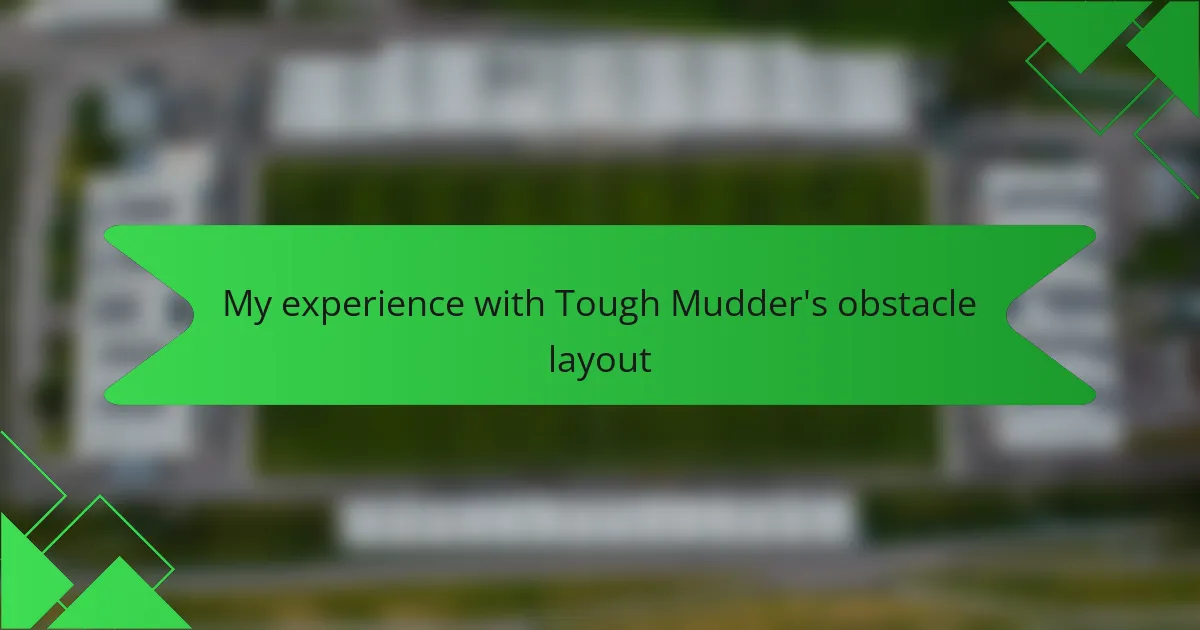Key takeaways
- Obstacle Course Racing (OCR) combines running with physical challenges to test strength, endurance, and mental toughness.
- Tough Mudder events emphasize teamwork and camaraderie, making every challenge a shared experience among participants.
- Key obstacles like the Berlin Walls, Arctic Enema, and Electroshock Therapy not only challenge physical abilities but also require mental grit.
- Successful strategies include pacing, leveraging teamwork, and reframing challenges as opportunities to enhance performance.

What is obstacle course racing
Obstacle course racing (OCR) combines running with challenging physical obstacles designed to test strength, endurance, and agility. From my experience, it’s more than just a race; it’s a full-body adventure that pushes your limits while keeping your mind sharp. I remember feeling both exhausted and exhilarated after conquering my first set of obstacles, a mix of fatigue and pride that’s hard to describe.
| Aspect | Obstacle Course Racing |
|---|---|
| Primary Focus | Combination of running and physical challenges |
| Physical Demands | Strength, endurance, agility, and mental toughness |
| Typical Obstacles | Climbing, crawling, jumping, carrying heavy objects |
| Experience | Challenging yet rewarding; promotes camaraderie |

Overview of Tough Mudder event
Tough Mudder events are designed to push both your physical and mental limits through a series of challenging obstacles. From my experience, each event feels like a unique test of endurance where teamwork often becomes just as important as individual strength. One moment I vividly recall was overcoming a muddy crawl under barbed wire, which was as humbling as it was exhilarating.
What sets Tough Mudder apart for me is not just the intensity of the obstacles, but the camaraderie that develops among participants. The layout mixes steep climbs, water obstacles, and electrified sections that demand strategy and courage. Here are some key features I encountered in the obstacle layout:
- Varied terrain combining mud, hills, and water to test stamina
- Electrifying obstacles like “Electroshock Therapy” that require mental toughness
- Team-based challenges encouraging participants to help each other
- Crawling under barbed wire through thick mud to challenge agility
- Wall climbs and rope swings to test upper body strength and coordination
- Water submersion obstacles adding an element of cold resistance and fear factor
This blend of obstacles truly makes every Tough Mudder event an unpredictable and deeply rewarding experience.

Key obstacles in Tough Mudder layout
The obstacle layout at Tough Mudder challenges you in ways you don’t expect—it’s not just physical but mental muscle too. I remember facing the Berlin Walls, those towering wooden barriers felt impossible at first, but the rush of overcoming them with teammates made every scrape worth it.
Some obstacles tested my endurance, while others pushed my fears to the limit. For example, the Arctic Enema had me gasping for breath, but the shared struggle with fellow racers created a unique bond that still sticks with me.
- Berlin Walls: towering wooden barriers requiring teamwork to scale
- Arctic Enema: waist-deep ice water plunge testing pain tolerance
- Electric Eel: crawling under low wires with shocks to intensify the challenge
- Funky Monkey: monkey bars demanding upper-body strength and agility
- Glory Blades: horizontal spinning blades requiring timing and balance
- Kiss of Mud: muddy crawl through tight spaces forcing grit and determination

Physical challenges faced during Tough Mudder
During Tough Mudder, the physical challenges really pushed me to my limits. The obstacles tested not only my strength but also my endurance and mental grit. I remember the freezing water plunge — it shocked my system but pushed me to keep going despite the numbness creeping in.
| Obstacle | Physical Challenge Faced |
|---|---|
| Arctic Enema | Extreme cold endurance; required mental toughness to overcome shock and muscle stiffness |
| Funky Monkey | Upper body strength and grip endurance; tricky swinging motions that demanded control and stamina |
| Electroshock Therapy | Stamina and pain tolerance; navigate electric shocks while maintaining forward movement |

Strategies to overcome Tough Mudder obstacles
When I tackle Tough Mudder obstacles, I find pacing myself is key—rushing leads to wasted energy and mistakes. For example, during the Funky Monkey, slowing down just enough to steady my grip made all the difference; have you ever noticed how controlling your breathing helps maintain focus under pressure?
Another strategy I swear by is leaning on teamwork. The Berlin Walls felt daunting until a few teammates offered a hand, turning a solo struggle into a group victory. It’s amazing how much a simple boost or encouragement can shift your mindset and push you through.
Finally, mental rehearsals helped me prepare for the unexpected shocks—literally. Before the Electroshock Therapy, imagining the jolts as brief interruptions rather than obstacles allowed me to push forward without hesitation. Have you tried reframing discomfort as a challenge to conquer instead of a barrier? It really changes the game.

Personal reflections on Tough Mudder experience
Reflecting on my Tough Mudder experience, I realize it was as much a mental journey as a physical one. There were moments when my body screamed to stop, yet something deeper kept me moving forward—a stubborn mix of determination and the contagious energy from everyone around me. Have you ever felt that surge when exhaustion turns into exhilaration? That feeling stuck with me long after the race ended.
I also found that the unpredictable obstacle layout forced me to stay adaptable, which was both frustrating and empowering. Each challenge felt like a puzzle where I had to quickly figure out not just how to complete it, but how to do so efficiently and safely. It made me appreciate the importance of being present and trusting my instincts in the moment.
Finally, the camaraderie I experienced during Tough Mudder made the whole ordeal meaningful beyond the mud and sweat. Helping a teammate over a wall or sharing a laugh after a tough crawl created bonds I didn’t expect. Isn’t it amazing how a grueling race can turn strangers into allies through shared struggle?

Tips for future Tough Mudder participants
One tip I’d stress is to train for variety. Tough Mudder isn’t just about running fast; it demands strength, agility, and mental grit in equal measures. When I started incorporating different workouts—from grip strength exercises to cold exposure training—it made the shocks and climbs feel less intimidating on race day. Have you ever noticed how mixing up your routine can boost your confidence?
Another important piece of advice is to embrace teamwork wholeheartedly. At one point, I was stuck halfway up the Berlin Walls, nearly ready to give up, when a teammate’s simple “You got this!” and a helping hand propelled me over. That moment reminded me how much of this race is about mutual support, not just individual toughness. Doesn’t that make the whole experience richer?
Lastly, pay close attention to pacing yourself throughout the event. Early on, I blasted through obstacles, feeling invincible, only to hit a wall halfway through. Learning to listen to my body—balancing speed with steady energy—helped me finish strong without feeling completely drained. How often do we overlook pacing until it’s too late?
